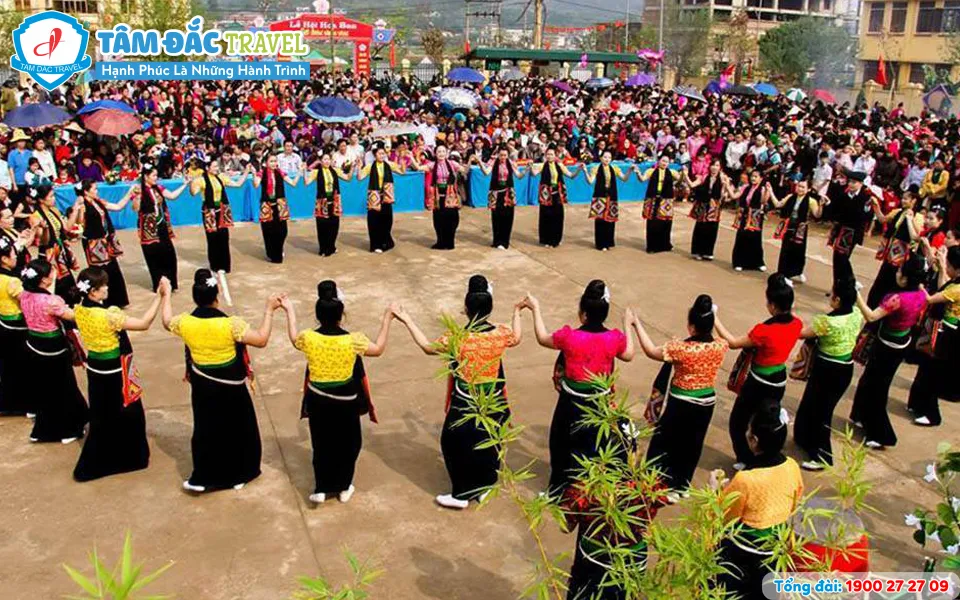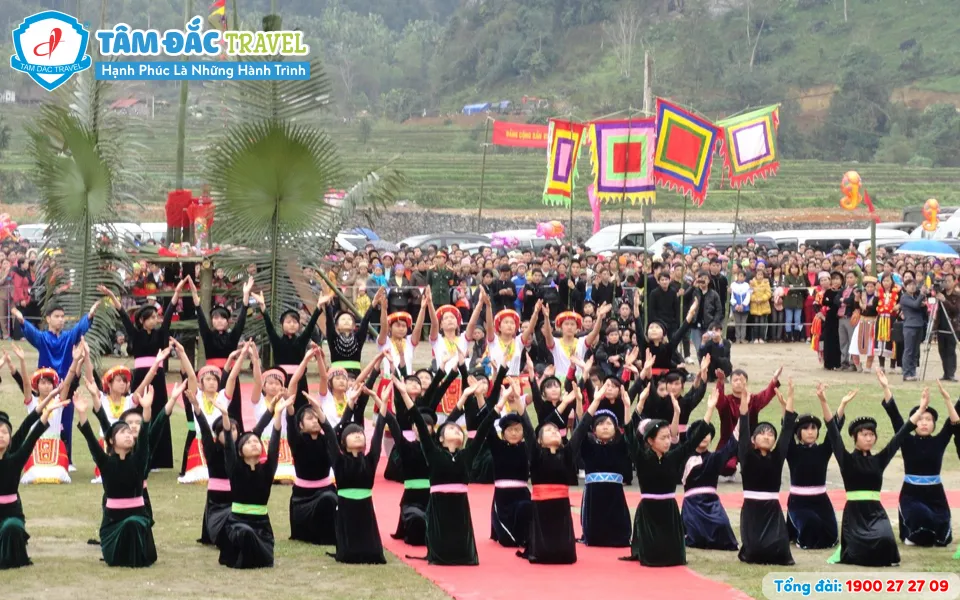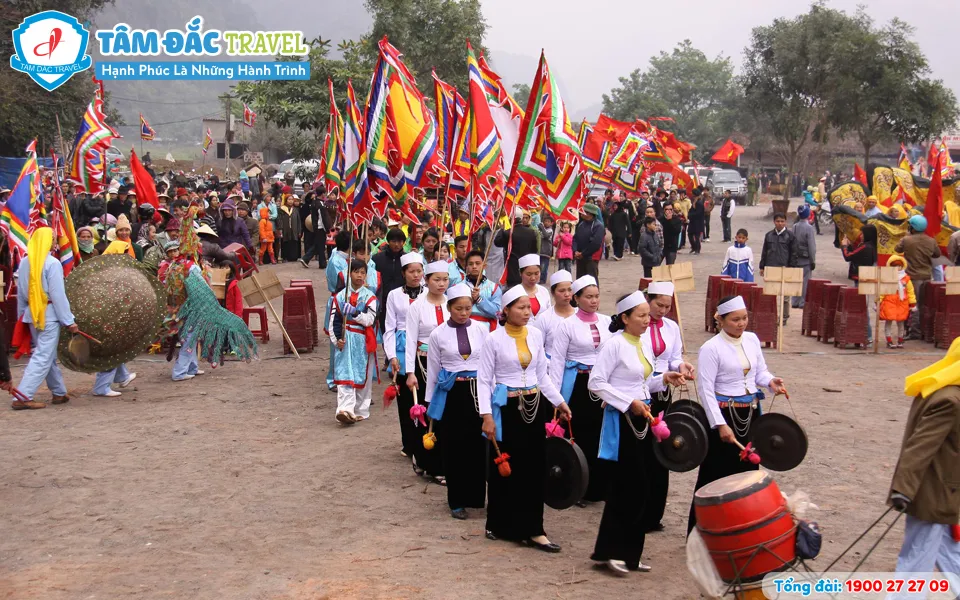Northwest Vietnam, a land generously endowed by nature with majestic landscapes of rolling mountains, terraced fields, and magnificent waterfalls, captivates visitors not only with its natural beauty but also with the richness and diversity of its traditional culture. This region is the cradle of many ethnic minorities, each possessing unique customs, practices, and deeply rooted traditional festivals. Immersing yourself in the festive atmosphere of Northwest Vietnam offers travelers the chance to witness distinctive cultural beauty and gain a deeper understanding of the spiritual life, beliefs, and traditional values preserved through generations. Join “Du lịch khắp thế gian” (Travel Around the World) to explore the most unique festivals of the Northwest highlands, where culture and nature harmonize, creating unforgettable experiences.
1. Hoa Ban Festival: A Spring Love Song of the Thai People
The Hoa Ban Festival is one of the most typical and anticipated festivals of the Thai people in Northwest Vietnam, especially in Dien Bien and Son La. More than just an occasion for people to commemorate the merits of deities, pray for favorable weather, bountiful harvests, and a prosperous life, the Hoa Ban Festival is also a cultural symbol, a place to showcase the spiritual values and traditional beauty of the Thai ethnic group.
The festival is usually held in the second lunar month of the year, when the Ban flowers bloom white across the mountains and forests of the Northwest. Hoa Ban is not only a characteristic flower of this mountainous region but also associated with the legend of Lady Ban, a beautiful and faithful maiden, symbolizing love and chastity. The Hoa Ban Festival is imbued with the spiritual and religious culture of the Thai people, expressed through solemn and meaningful rituals:
- Inviting the Then God: The Then God is considered the supreme deity in the beliefs of the Thai people, governing everything in the universe and human life. The ritual of inviting the Then God expresses the people’s respect and gratitude towards the supreme deity.
- Inviting Lady Ban: Lady Ban is a legendary figure, a symbol of beauty, fidelity, and love. Inviting Lady Ban is the way people express admiration and pray for beautiful and happy love.
- Inviting other deities: In addition to the Then God and Lady Ban, people also invite the gods of heaven, gods of villages, gods of mountains, gods of rivers… These are the gods and spirits believed to protect the lives and crops of the people.
Besides the solemn ceremonial part, the Hoa Ban Festival also has an extremely vibrant and attractive festive part. This is an opportunity for the community to socialize, have fun, and showcase the unique cultural features of their ethnic group. Activities in the festive part often include:
- Folk games: “Ném còn” (throwing cloth balls), kéo co (tug-of-war), đi cà kheo (walking on stilts), leo cây (tree climbing), chọi cù (top spinning)… are popular traditional games, attracting a large number of people and tourists to participate. These games are not only entertaining but also demonstrate the martial spirit, dexterity, and solidarity of the community.
- Call and response singing, Xòe dance: The graceful and rhythmic Xòe dances along with sweet and deep folk melodies create a joyful atmosphere imbued with Thai cultural identity. Call and response singing is a unique form of cultural exchange, demonstrating the intelligence, humor, and eloquence of the people.
- Highland market fair: During the festival days, the highland market fair becomes more bustling than ever. This is a place for people to exchange and trade goods, enjoy local cuisine, and meet and socialize. Visitors can find unique handicrafts, specialty dishes, and immerse themselves in the vibrant atmosphere of the market fair.
The Hoa Ban Festival is not only a cultural event but also a unique tourism product, attracting tourists to Northwest Vietnam in the spring. Coming to the festival, visitors will admire the beauty of Hoa Ban flowers, immerse themselves in the bustling festival atmosphere, and discover the unique cultural beauty of the Thai people.

2. Lồng Tồng Festival: The Tày People’s Festival for Spring Plowing and Crop Praying
The Lồng Tồng Festival, also known as the spring plowing festival, is one of the most important and long-standing festivals of the Tày ethnic group in the Northwest mountains of Vietnam, particularly popular in the provinces of Lang Son, Cao Bang, Bac Kan, and some localities in Lao Cai and Yen Bai. The festival is deeply imbued with the mark of wet rice agricultural culture, expressing the aspiration for a prosperous, happy life and bountiful harvests.
The Lồng Tồng Festival is usually held around January or February of the lunar calendar, after the Lunar New Year, when spring arrives and farmers prepare for the new planting season. The name “Lồng Tồng” in the Tày language means “going to the fields,” clearly expressing the main purpose of the festival, which is to pray for favorable weather and good crops.
Before the festival day, the atmosphere of preparation is bustling throughout the Tày villages. Houses are cleaned, and village roads and alleys are decorated with flags and flowers. Families prepare offering trays with traditional dishes such as “bánh chưng” (square sticky rice cake), “bánh giày” (round sticky rice cake), “bánh bỏng” (popped rice cake), “chè lam” (sticky rice candy with ginger)… Especially, on the offering tray, there must be two pairs of “Lồng Tồng fruits” made of colored cloth, filled with sand or cotton inside, with colorful tassels. The Lồng Tồng fruit symbolizes fertility, prosperity, and luck.
The Lồng Tồng Festival includes two main parts: the ceremony and the festival, each part carrying its own meanings and unique features.
- Ceremony Part: The ceremony is conducted solemnly and respectfully. The procession of the God of Agriculture and the Village Guardian God from the communal house to the field is led by respected elders in the village, followed by teams of strong young men. Families bring the offering trays they have prepared, displaying them in the festival ground. The shaman or the festival host will perform the ritual of offering and praying to the deities, praying for favorable weather, bountiful harvests, and peaceful life. The offering ritual is often accompanied by the Lồng Tồng “Mo” song, a unique form of Tày folk performance. After the offering, the host will announce “breaking the offering,” and everyone will enjoy the dishes on the offering tray together and wish each other a new year of peace and luck. According to the Tày people’s belief, families with many guests coming to “break the offering” will have good luck and fortune in that year.
- Festival Part: The Festival part of Lồng Tồng takes place extremely lively and joyfully, attracting a large number of people and tourists to participate. The activities in the festival part are very diverse and rich, imbued with the traditional culture of the Tày people:
- Art performances: “Hát Then” (Then singing), “Hát Cọi” (Cọi singing), Xòe dance, “Đàn Tính” (Tính lute)… are unique folk art forms of the Tày people performed in the festival. The sweet and deep Then and Cọi melodies, the graceful and rhythmic Xòe dances, and the melodious Tính lute sounds create a bustling and joyful festival atmosphere.
- Folk games: Tug-of-war, đẩy gậy (stick pushing), đánh trống (drumming), ném còn (throwing cloth balls), pole climbing, rice plowing competition… are popular traditional games, attracting a large number of people to participate. These games are not only entertaining but also demonstrate the martial spirit, dexterity, strength, and solidarity of the community. In particular, the “ném còn” (throwing cloth balls) game is considered a characteristic feature of the Lồng Tồng festival, with the cloth ball thrown high symbolizing the wish for good crops and a prosperous life.
The Lồng Tồng Festival is not only a religious and cultural activity but also an opportunity for people to connect the community, exchange cultures, and have fun and entertainment after days of hard work. For tourists, the Lồng Tồng Festival is a great opportunity to discover the unique cultural beauty of the Tày people, experience the bustling festival atmosphere, and learn about the spiritual life and beliefs of the people in the Northwest highlands.

3. Cầu An Bản Mường Festival: The Spiritual and Cultural Beauty of the Thai People
The Cầu An Bản Mường Festival is a large and significant festival in the cultural and religious life of the Thai people in Northwest Vietnam. The festival is held to commemorate the merits of the deities who created the “Ban Muong” (the living land of the Thai people), and to pray for peace, prosperity, and happiness for the community and bountiful harvests.
The Cầu An Bản Mường Festival is usually held in spring or autumn, depending on the locality and customs of each “Ban Muong”. The festival is deeply imbued with spiritual culture, expressed through solemn worship rituals and the sincere participation of the community.
One of the most important rituals of the festival is the custom of slaughtering buffaloes to sacrifice to the gods. Depending on the scale and conditions of each “Ban Muong”, one to four buffaloes may be slaughtered to offer to the deities. Buffaloes chosen for sacrifice must be healthy and disease-free, symbolizing prosperity and strength.
The ceremony part of the Cầu An Bản Mường Festival usually includes the following rituals:
- Preparing offerings: Offerings are usually very rich and elaborately prepared, including buffalo meat, rice, wine, sticky rice, chicken, pork, fruits, cakes… The offering tray is usually decorated solemnly and beautifully, expressing the people’s sincerity towards the deities.
- Worship Rituals: The worship ritual is performed by a shaman or a respected person in the “Ban Muong”. The shaman will recite prayers, inviting the deities to attend the ceremony and receive the offerings. The worship ritual usually takes place solemnly and respectfully, with the participation of a large number of people in the “Ban Muong”.
- Distributing blessings: After the worship, buffalo meat and other offerings will be distributed equally to families in the “Ban Muong” to receive blessings. This is a beautiful cultural feature, expressing sharing and community bonding.
The festival part of the Cầu An Bản Mường Festival is also lively and joyful, with many attractive cultural, artistic, and folk games:
- Folk Arts: “Hát khắp” (Khap singing), “Hát giao duyên” (love duet singing), “Múa sạp” (bamboo dance), Xòe dance, “Nhảy sạp” (bamboo jumping dance)… are unique art performances presented at the festival. Sweet and deep folk melodies, graceful and rhythmic dances create a joyful and excited atmosphere.
- Folk Games: Ném còn (throwing cloth balls), đánh cồng chiêng (gong playing), kéo co (tug-of-war), bắn nỏ (crossbow shooting), đi cà kheo (walking on stilts)… are popular traditional games, attracting a large number of people to participate. These games are not only entertaining but also demonstrate the martial spirit, dexterity, and solidarity of the community.
- Cultural Exchange: The Cầu An Bản Mường Festival is an opportunity for neighboring “Ban Muong” to exchange cultures, learn from experience, and strengthen solidarity. People from different “Ban Muong” come to attend the festival, have fun, sing, and share the cultural beauty of their ethnic groups.
The Cầu An Bản Mường Festival is an indispensable part of the spiritual and cultural life of the Thai people in Northwest Vietnam. The festival not only expresses gratitude to the deities but is also an opportunity for the community to bond, preserve, and promote good traditional cultural values. Coming to the festival, visitors will experience a unique spiritual cultural space and gain a deeper understanding of the spiritual life of the people in the highlands.

4. Cầu Mưa Festival: Wishing for Bountiful Harvests
The Cầu Mưa Festival (Rain Praying Festival) is a unique and popular cultural and religious activity of many ethnic minorities in Northwest Vietnam, especially the Thai, Muong, and Dao people. The festival is held to pray for favorable weather, bountiful harvests, livestock development, and a prosperous and happy life.
The Cầu Mưa Festival is usually held in the dry season, before the rainy season begins, when farmers are worried about drought and look forward to rain to water their fields. The time of holding the festival may vary depending on the locality and customs of each ethnic group, but it usually falls around March or April of the lunar calendar.
The Cầu Mưa Festival is deeply imbued with agricultural beliefs, expressing the dependence of humans on nature and the aspiration for a full and prosperous life. The festival usually includes two main parts: the ceremony and the festival.
- Ceremony Part: The ceremony is conducted solemnly and respectfully, with worship rituals praying for favorable weather. Worship rituals may vary depending on each ethnic group and locality, but usually include:
- Worshiping the Rain God: The Rain God is considered the deity who has the power to control rain and wind, bringing water for crops. The ritual of worshiping the Rain God expresses respect and seeks blessings from this deity.
- Worshiping other deities: In addition to the Rain God, people also worship other deities such as the Earth God, Mountain God, River God… to pray for protection and support for life and crops.
- Water Procession: The water procession ritual is an important ritual in the Cầu Mưa Festival. Water is carried from sacred water sources such as rivers, streams, wells… to be poured on plants and fields, symbolizing the prayer for rain to come.
- Festival Part: The Festival part of the Cầu Mưa Festival takes place joyfully and bustlingly, with many attractive cultural, artistic, and folk games:
- Folk Arts: Nursery rhymes, “Ví” singing, lullabies, water puppetry, rain praying dances and songs… are unique art performances presented at the festival. Folk songs and dances with the theme of rain praying express the people’s desire for favorable weather.
- Folk Games: Ném còn (throwing cloth balls), swing sets, blindfolded goat catching, tug-of-war, boat racing… are popular traditional games, attracting a large number of people to participate. These games are not only entertaining but also demonstrate the community spirit, solidarity, and strength of people in working life.
- Drinking “Rượu cần” (straw wine), cultural exchange: In the festival atmosphere, everyone drinks “Rượu cần” together, enjoys local cuisine, and exchanges cultures. This is an opportunity to strengthen solidarity, community bonding, and share common joys and aspirations.
The Cầu Mưa Festival is not only a religious activity but also a community cultural activity with profound educational significance. The festival helps people better understand the relationship between humans and nature, and realize the importance of water for life and agricultural production. At the same time, the festival also contributes to preserving and promoting the good traditional cultural values of ethnic minorities in Northwest Vietnam. Coming to the Cầu Mưa Festival, visitors will experience a unique cultural space and feel the simple but sacred aspirations of the people in the highlands.